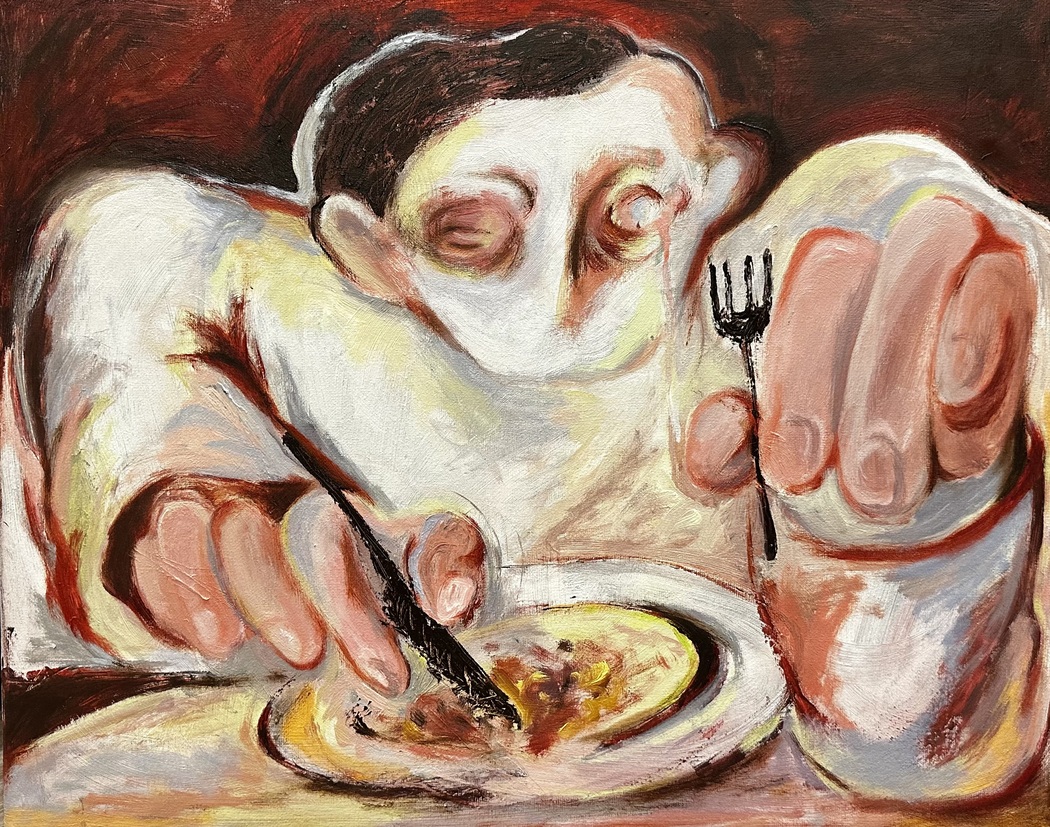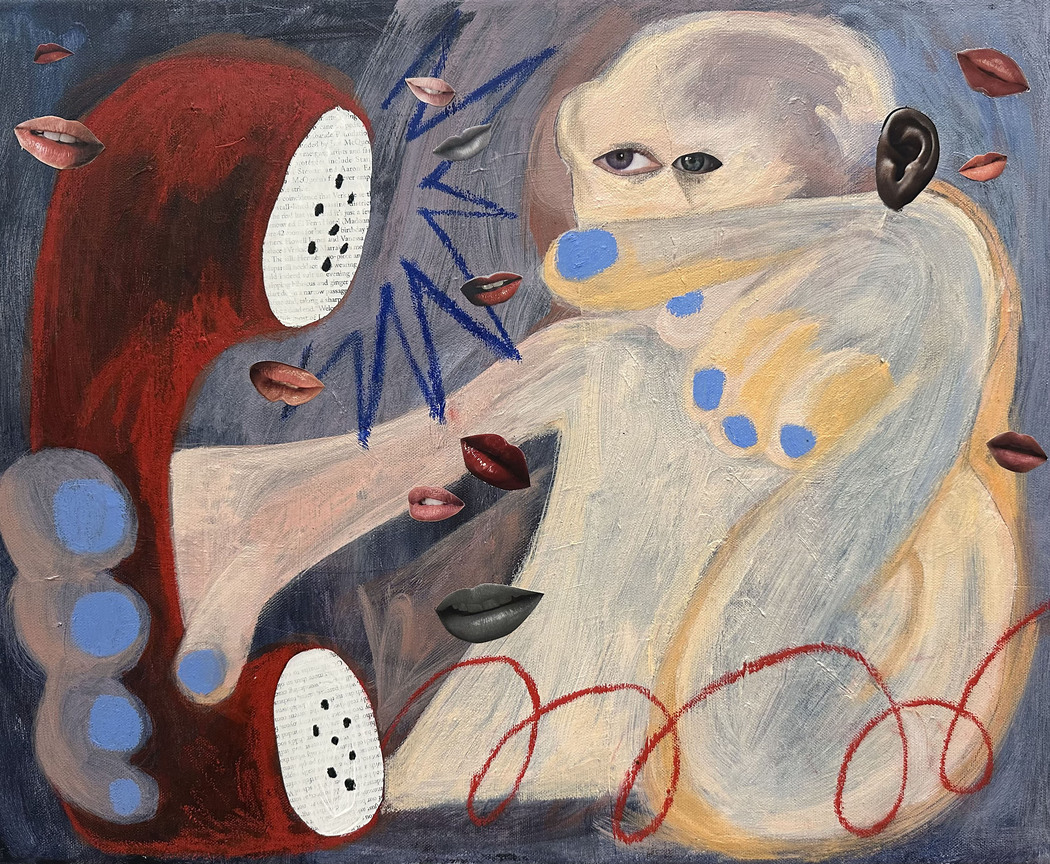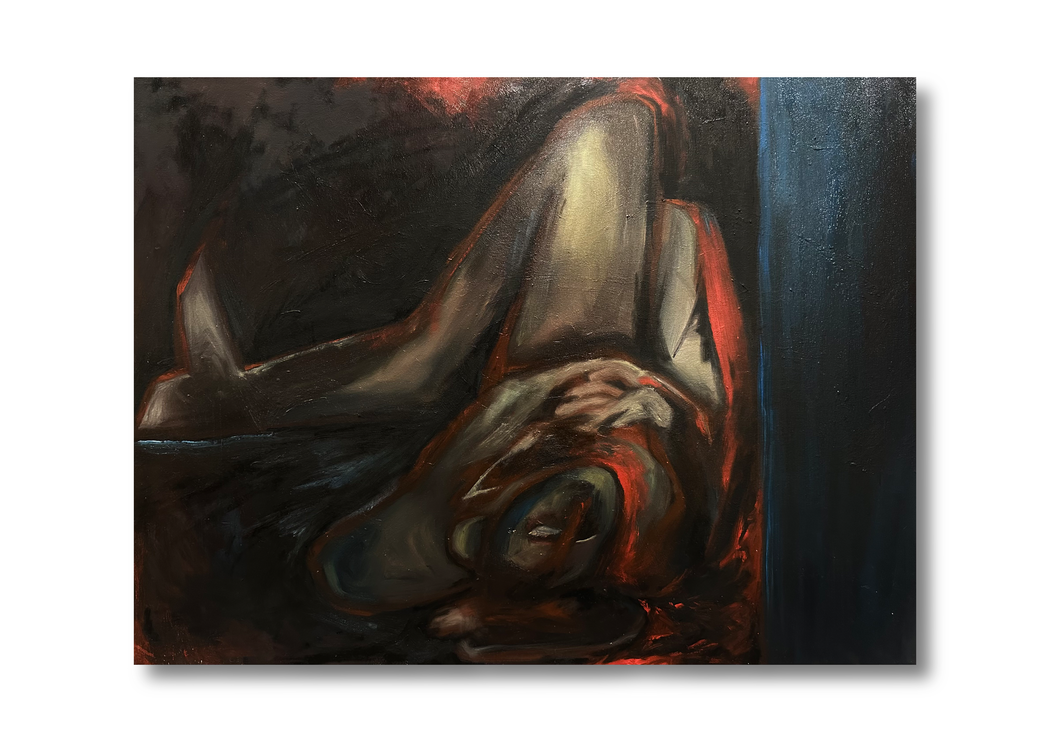Tianxi Wang
 Tianxi Wang | The Eager Diner | 2025
Tianxi Wang | The Eager Diner | 2025
Your artwork explores themes of identity, memory, and emotional connection. Can you elaborate on how these themes are intertwined in your work and how they manifest in your creative process?
My work is deeply rooted in personal experiences and the nuances of everyday life, which I translate into symbolic and surreal visual narratives. Themes of identity, memory, and emotional connection are central to my practice—they’re not treated as separate ideas but rather as interconnected threads that shape how we experience the world and relate to others. By incorporating surrealism and symbolism—such as distorted landscapes or exaggerated human forms—I aim to reframe the ordinary, giving emotional weight to otherwise familiar scenes. This approach allows me to explore the subtle dynamics of human interaction and our often fragile relationship with our environment. Through these visual metaphors, I invite viewers to reflect on their own memories and identities, and how these inform their perception of the spaces and people around them. Ultimately, my creative process is about amplifying the emotional undercurrents of daily life—elevating quiet moments into compelling narratives that resonate on both a personal and universal level.
How do you decide on the materials you use? What role do oil paint, acrylic, and collage play in your exploration of texture and materiality?
My choice of materials is often guided by curiosity and intuition. Initially, collage was simply a way to create mood boards—an exercise in visual brainstorming. But I quickly became fascinated by the process itself: combining found imagery to form new, unexpected narratives. It felt both spontaneous and experimental, which is something I deeply enjoy in my practice. My love for fashion played a big role in this evolution, especially after discovering the work of Jacky Marshall. Her fashion collages inspired me to push the boundaries of the form and develop my own voice in that space. The process is unpredictable, and that’s part of what excites me—sometimes the most striking compositions happen by accident. Eventually, I began integrating collage into my painting practice. I often start with magazine cutouts and play with compositions through sketches, exploring different stories that could emerge from even just two images. That phase is very playful and generative—there’s a lot of freedom in imagining what could be built from fragments. When it comes to painting, I enjoy working with both oil and acrylic for their distinct qualities. I’m particularly drawn to texture—whether it’s the smooth blendability of oil or the more immediate, layered feel of acrylic. Each medium allows me to experiment with surface and materiality in a different way, adding depth and emotion to the work. Ultimately, it’s the interplay between control and chance, between material and meaning, that keeps me engaged with these different approaches.
You describe your painting process as meditative. Can you walk us through your process from the initial idea to the final brushstroke?
I approach painting as a meditative process—a space for reflection and emotional processing. My work often begins with personal experiences, everyday objects, and moments of self-reflection. These elements serve as bridges between my inner world and the broader context of society and environment. Objects from daily life carry emotional weight and cultural meaning, while themes like family and connection reflect the ways in which relationships shape our sense of identity and belonging. I often use self-portraits and human figures as emotional mirrors, expressing states like calm, stress, or uncertainty through form, gesture, and color. These figures become symbolic vessels through which I explore the fluid, ongoing dialogue between internal emotion and external experience. In my paintings, I focus on capturing subtle emotional states through the use of color, composition, and expression. I’m particularly interested in how mood can be conveyed without words—through the posture of a figure, the tension in a gesture, or the atmosphere created by certain hues. Everyday scenes and objects often appear in my work, not just as background elements, but as meaningful representations of personal memory or emotional weight. A quiet room, a piece of clothing, or an empty chair can become metaphors for connection, absence, or longing. By combining these elements with a focus on the inner self, my aim is to create visual narratives that evoke a sense of familiarity while encouraging viewers to reflect on their own emotional landscapes.
 Tianxi Wang | Stop | 2025
Tianxi Wang | Stop | 2025
In your work, there is a balance between the surreal and the tangible. How do you navigate this dynamic and what do you hope to convey through it?
Balancing the surreal and the tangible allows me to explore emotional and psychological states in a way that feels both grounded and expansive. I often start with real-life references—objects, spaces, or people that hold personal or cultural significance—and then reimagine them through a surreal lens. This blending of the familiar and the fantastical creates a visual tension that mirrors the complexity of human emotion and perception. Surreal elements, such as distorted figures or dreamlike environments, help me to exaggerate or amplify feelings that might otherwise go unnoticed in everyday life. Through this dynamic, I aim to invite viewers into a world that feels intimate yet open to interpretation. The tangible aspects make the work relatable, while the surreal touches encourage a deeper, more introspective engagement. By pushing the boundaries of realism, I hope to evoke emotional responses that go beyond the literal—to create a space where personal memories, emotions, and subconscious thoughts can surface. Ultimately, it’s about using visual language to explore the in-between spaces—the quiet, layered moments where the internal and external worlds intersect.
How does your background in illustration influence your approach to mixed media, and how do you see your style evolving in the future?
My background in illustration has had a strong influence on how I approach painting and mixed media. Illustration trained me to think in terms of storytelling, composition, and visual clarity—all of which continue to shape how I build narratives within my work. Even when working with abstract or surreal elements, I often begin with a structured visual idea or sketch, a habit that comes from my illustration practice. This foundation helps me to layer emotional content and symbolic meaning with intention, even as I allow for spontaneity in the process. As I continue to explore mixed media, I see my style evolving toward a more fluid and intuitive approach. I’m becoming increasingly interested in how materials, texture, and color can carry emotional weight on their own—beyond the illustrative structure. While illustration gave me the tools to communicate visually, mixed media opens up new possibilities for expression that are more tactile, raw, and experimental. Moving forward, I hope to push the boundaries between figurative and abstract, combining disciplined techniques with freer, more instinctive mark-making to create work that feels both emotionally honest and visually layered.
Can you tell us more about the emotional landscapes you create in your work? How do you capture the complexities of human experience through color and form?
The emotional landscapes in my work are shaped by an ongoing exploration of inner states—feelings that are often difficult to articulate with words. I use color and form as emotional tools, allowing them to carry the weight of moods like vulnerability, anxiety, calm, or nostalgia. For me, color is never just aesthetic; it’s deeply intuitive and tied to emotion. A muted palette might evoke stillness or melancholy, while vibrant contrasts can express tension or inner conflict. I rely on these visual cues to create an atmosphere that speaks to the viewer on a visceral level. Form and figure also play a key role. Whether through a subtle gesture, an ambiguous expression, or a slightly distorted body, I try to convey emotional nuance—the kind that exists in everyday moments or quiet reflections. I’m drawn to the complexity of the in-between, the spaces where feelings overlap or contradict each other. Sometimes, I incorporate everyday objects or domestic scenes to ground the work in something familiar, making the emotional undercurrents more accessible. Ultimately, my goal is to create a space where viewers can sense something deeply personal yet universally human, inviting them to connect with their own emotions through mine.
 Tianxi Wang | The man lying on the ground | 2024
Tianxi Wang | The man lying on the ground | 2024
You mentioned that your art is inspired by both lived experiences and cultural influences. How do these elements manifest in your pieces?
My art is deeply shaped by both my lived experiences and the cultural environments I’ve been part of. Having lived in places like New York, Edinburgh, and London, I’ve absorbed a wide range of influences—each city offering its own atmosphere, rhythm, and visual language. The architecture, social dynamics, and even the light in these places have left subtle imprints on how I perceive space, emotion, and human interaction. These impressions often find their way into my work, not always in literal representations, but in the mood, color palette, or emotional tone of a piece. I’m especially interested in how different cultural contexts influence our sense of identity and connection. Moving between these places made me more aware of what feels familiar versus what feels foreign, and that contrast often appears in my compositions. Sometimes it’s through fragmented imagery, or through figures that seem caught between states—between places, emotions, or identities. These elements reflect my own experience of navigating multiple environments, and they also allow me to explore broader themes of memory, displacement, and belonging.

Leave a Reply